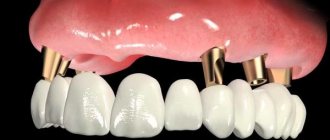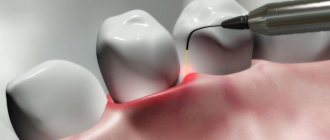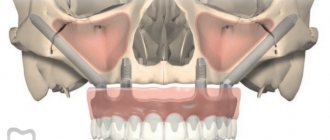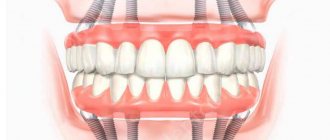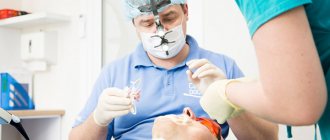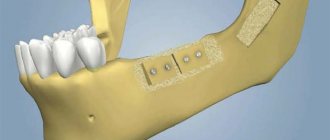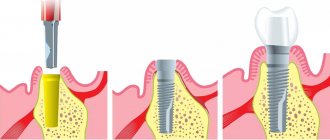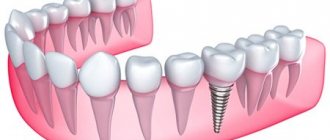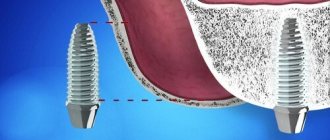What implantation methods are used today?
The classical implantation technology is considered to be a two-stage method, in which 3-6 months must pass between the implantation of artificial roots and the final fixation of the prosthetic device. In addition, the treatment may be prolonged due to the need for preliminary bone grafting, without which in most cases it is impossible to reliably fix the implants in the atrophied bone tissue. Currently, this concept is used mainly for single restorations in the smile zone, because it allows the formation of an almost perfectly smooth gingival margin, thereby ensuring a high level of aesthetics of the result.
What methods of implantation in 1 day are there?
It’s another matter if the patient has multiple defects in a row, all teeth have been lost, or only those that need to be urgently removed remain. In such a situation, the use of the classical technique will be unreasonably expensive, and the treatment itself will last for a very long period of time. Modern dental implantology offers an excellent solution to the problem - comprehensive protocols for immediate loading, which allow you to restore the aesthetics and functionality of your smile in the shortest possible time and for an adequate price. Among the key characteristics of one-stage implantation methods:
- almost instantaneous fixation of the prosthetic device after implantation - from 1 to 7 days,
- the ability to avoid bone grafting, thanks to the inclined installation of titanium rods in the distal sections or the implantation of elongated zygomatic models in the upper jaw (Nobel Zygoma, Zygomatic from Southern Implants, Zygomatic from Noris Medical, as well as zygomatic models from Oneway Biomed for basal implantation),
- the use of a reduced number of artificial roots, which means saving money for the patient,
- 3D visualization of each stage of treatment, which allows you to eliminate the risks of any shortcomings and complications.
Using a reduced number of artificial roots
Patients do not have to wait a long time to restore their usual lifestyle.
After installing the implants, the prosthesis is fixed with a strong metal beam, which unites the artificial roots and holds them in the desired position until complete healing. The process of osseointegration occurs much faster, because the jawbone almost immediately begins to receive the necessary load, due to which metabolic processes are activated, and therefore bone restoration is accelerated. In addition, it is possible to implant implants into the sockets of newly extracted teeth using one-step technology, but this opportunity does not arise often. Typically, patients seek help when the remaining teeth require immediate removal, and immediate extraction and implantation of a titanium rod requires certain preparation.
What are the disadvantages?
The service life of all temporary structures is limited to several months. Then you will need to return to prosthetics. Removable products are inconvenient to use - they need to be cleaned several times a day.
When choosing dental prosthetics in one day using implants, you need to be prepared for the high cost of the service. Expensive materials are used for their manufacture. In addition, express implantation is conventionally classified as rapid prosthetics. It is preceded by a thorough medical examination. The procedure has many contraindications.
The most popular implant brands and price comparison
Currently, there are three main manufacturers at the peak of popularity: Nobel Biocare, Astra Tech and Straumann. These companies provide a lifetime guarantee on implants, however, their products are far from cheap. It should also be noted that world leaders in the production of implantological systems also offer their own developments in the field of technology for implanting artificial roots. The table below shows the ranking of leading implant brands and average prices for comparison.
| Manufacturing company | Approximate cost of 1 standard implant, rub. |
| Nobel Biocare (Switzerland) | from 40 000 |
| Astra Tech (Sweden) | from 40 000 |
| Straumann (Switzerland) | from 40 000 |
| ROOTT (Switzerland) | from 40 000 |
| Ankylos (Germany) | 30-40 000 |
| BioHorizons (USA) | 25-35 000 |
| MIS (Israel) | from 12 000 |
| Alpha Bio (Israel) | from 12 000 |
To be able to work with products from the world's leading brands, a specialist must first undergo additional training and master the operating technologies developed by the manufacturing company. As for one-stage treatment protocols, here the implantologist also requires excellent knowledge of modern computer 3D visualization programs, without which it is impossible to carefully plan each stage of treatment.
Indications and contraindications
With the help of one-stage implantation, both one lost tooth and several are replaced. Although preference is given to this method in cases of complete edentia. If it is necessary to restore one chewing unit, the standard method is preferred. This is due to the fact that conventional implants can withstand greater loads.
Basal restoration is also carried out at the request of the patient, when restoration is necessary as soon as possible. Contraindications include :
- mental disorders;
- tuberculosis;
- cancer;
- HIV AIDS;
- diseases of the cardiovascular system;
- pregnancy and lactation.
Important! Dentists cannot guarantee the long service life of implants installed for people whose profession is associated with an increased risk of injury.
Implantation in 1 day - modern protocols
Above, we have identified the main characteristic features of complex methods for restoring teeth in 1 day. However, this category includes several protocols, each with its own special characteristics. Let's look at all these concepts in more detail.
All-on-3 (Trefoil) for the lower dentition
This protocol is indicated for the restoration of the lower row. Artificial roots, in an amount of only 3 pieces, are evenly distributed in the front area of the jaw, and are fixed strictly straight. After this, they are put on a lightweight model of a prosthetic device with a metal beam and plastic crowns.
Implantation according to the All-on-3 protocol
“If we talk about Trefoil technology, here the degree of bone tissue atrophy in the lateral sections plays a minimal role, while in the frontal zone the jawbone must be in acceptable condition in order to reliably fix the implants. To be fair, it should be noted that in the lower jaw in the anterior part, atrophic processes do not develop as quickly as in the upper and lateral parts,” explains Ivan Pavlovich Kopylov, maxillofacial surgeon and implantologist at Smile-at-Once Dentistry, which has become one of the first clinics in Russia where they began to practice the use of one-stage implantation techniques.
The cost of treatment using this technology in Moscow starts from 280 rubles for a full row with the installation of a temporary orthopedic structure. The protocol is a patented development of Nobel, which means that its use is possible only if the developer’s original products are used.
On 4 implants
The main protocol for implantation on 4 artificial roots is a technique called all-on-4, developed by Nobel and, accordingly, involves the use of implants of the same brand. Two implants are inserted in a straight position into the thickness of the bone tissue in the anterior section, and two more - on the sides at a slight angle. The method is used in cases of minor or moderate atrophy, and bone grafting can be avoided due to the inclined position of artificial roots. In case of emergency atrophy in the distal parts of the upper jaw, special zygomatic implants can be used - these are elongated models that are implanted directly into the zygomatic bone of the skull, which is not subject to atrophy or inflammation. Treatment will cost from 280 thousand rubles, including the installation of an adaptation device.
Implantation using the All-on-4 protocol
A similar protocol is also offered by Straumann. The Pro Arch technique is essentially identical to all-on-4 with the only key difference being that it uses the developer’s systems. By the way, Straumann also has the Pro Arch TL protocol - a prosthetic device with 6 implants. However, here analogues of dental roots are distributed evenly throughout the entire jaw and without an inclined installation. The cost of a new smile starts from 230 thousand rubles.
On 6 implants
This technology is considered an improved version of all-on-4, which is ideal for more severe atrophy. Implants in the amount of 6 pieces in a complex ensure reliable retention of the prosthetic apparatus. Two root analogs are placed in the anterior section, and two more in the lateral sections. In case of pronounced atrophic processes, from 2 to 4 zygomatic implants can be used.
Implantation according to the All-on-6 protocol
“Thank you very much to the doctors of your clinic! I had prosthetics done on 6 implants, and I didn’t even need bone grafting, although other clinics assured me that nothing could be done without it. The new teeth were installed on the 4th day, which I am still incredibly happy about. The operation was performed under general anesthesia, everything went well. Rehabilitation also went quite quickly and without complications. Overall, I am very pleased with the work of your specialists and am eternally grateful to them for my new smile!”
Ksenia Romanovna T., 58 years old, Moscow, review on the website of the dental clinic
The total cost of treatment starts from 230 thousand rubles with the condition of fixing a temporary prosthesis. However, this price provides for the use of more budget Osstem implants. If implantation is carried out using Nobel products, then the cost increases to 400 thousand.
Basal complex
In case of emergency atrophy of the jaw bone, complicated by inflammatory processes in the periodontal tissues, the optimal way out of the situation is Basal Complex - the technique involves the implantation of up to 12-14 artificial roots for reliable support of the prosthetic device. In this case, special models of the classic root-shaped form are used, but at the same time elongated. As a rule, these are one-piece designs with active or compression threads. Another feature of such implants is their smooth coating, which helps stop inflammatory processes and prevent peri-implantitis. Zygomatic models from Biomed can also be implanted.
Basal implantation method
The cost of implantation starts from 250 thousand rubles per row. The price is relatively low, but this does not in any way affect the quality and durability of the treatment results. The thing is that products are used here, which are characterized by a lower purchase cost, but at the same time very high quality.
How the treatment is carried out - a brief description of the process
Treatment takes about a week on average, but it must be taken into account that immediately before the procedure the patient will have to undergo thorough preparation. The table below shows the main stages of implantation using one-stage technologies and brief comments on them.
| Stages of treatment | Brief explanations |
| Stage 1: preparation | Examination of the patient's health status, passing all necessary tests and undergoing an orthopantomogram and CT scan for the most accurate assessment of the condition and volume of bone tissue. You may need to obtain permission from your physician and certain specialists. If there are damaged or rotten teeth, they are first removed. |
| Stage 2: 3D planning | Each stage of treatment is carefully calculated and modeled using advanced 3D modeling programs. CT data is transferred to special software, which is then used to select the optimal locations for implants and their models, and develop a prosthetic device and surgical templates necessary for the most accurate positioning of artificial roots. |
| Stage 3: implantation | In most cases, the process of fixing implants is carried out using a less traumatic method than the patchwork method used in the classical technique. There is no need to peel off the gums and apply stitches after surgery, due to which the rehabilitation process is much faster and easier for the patient - the soft tissues of the oral cavity hurt and remain swollen for literally several days, after which the condition returns to normal. In this case, both one- and two-piece implants can be used. |
| Stage 4: temporary prosthetics | The adaptive prosthesis provides a durable metal base that splints newly installed implants and prevents them from moving under chewing load. In some cases, it is possible to adjust the old prosthesis that the patient previously used, but in such a situation he will have to limit himself in food and carefully ensure that he does not accidentally disturb the positioning of the structures. At this stage, the cost includes not only the work of the orthopedic doctor, but also the dental technician who directly develops the prosthesis. |
| Stage 5: installation of a permanent prosthesis | The temporary orthopedic device should be worn until the artificial roots have completely fused with the bone tissue. However, in practice, such prosthetic devices cope perfectly with their functionality for a longer time - a maximum of 3 years. |
What do all three immediate load protocols have in common?
Many patients are interested in two main questions: is the method reliable and how can bone atrophy be avoided without augmentation? Single-stage implantation methods are based, so to speak, on “three pillars”, which provide answers to these questions:
- Implants for bone tissue atrophy are attached to the deep layers of the jaw, which are not subject to recession and inflammation. In addition, they are placed at a certain angle, which means the area of their contact with bone cells increases noticeably,
- the prosthesis is installed immediately - due to the metal base it is fixed to the implants, acting like a connecting bridge,
- instant chewing load: the fact that the denture is placed on the 3rd day is a necessity. The patient should immediately begin chewing, since it is thanks to this that the bone cells return to normal functioning and receive the nutrition necessary for growth.
The technique has other advantages. For example, the installed prosthesis allows you to immediately use the facial muscles, restoring their tone - as a result, the rejuvenation effect is guaranteed, the skin and wrinkles are instantly smoothed out.
Rejuvenation effect after dental implantation
All risks of implantation are minimized. Before starting treatment, 3D diagnostics are carried out, and with the help of special software the implantation process is simulated - from the moment of choosing a place for implants to installing the prosthesis. In this case, at the surgical stage, templates are used - silicone overlays in rows with holes for implants.
Sometimes before implantation it is necessary to remove damaged teeth; these two actions can be easily combined. Everything happens at the same time: the teeth are removed and implants are implanted in their place.
The use of surgical templates during the installation of implants for their precise positioning
What does the turnkey cost include?
Comprehensive restoration of the entire jaw is quite expensive. The cost consists of many different factors, and it is quite difficult to accurately calculate it in advance. A convenient option may be turnkey treatment. Thus, in many modern clinics they immediately announce the full price, taking into account all associated expenses, including the manufacture and installation of the prosthesis. So, let's take a closer look at what can be included in the cost of implantation:
- CT scan before and after surgery: some clinics include an x-ray examination in the full price, but this does not happen everywhere. In other institutions, the price of a computed tomography scan will cost from 2,500 rubles per image,
- tests: the situation is similar to the first point, that is, in some places this service is included in the price of treatment, but in other clinics it is not,
- 3D diagnostics and planning: a prerequisite for immediate loading protocols. The price thus includes the cost of the program itself, as well as training of specialists who work with such software,
3D diagnostics and planning: a prerequisite for immediate loading protocols. - local anesthesia: in most cases local anesthesia is sufficient, however, at the patient’s request, sedation or anesthesia can be used for an additional fee,
- tooth extraction: when the patient still has his teeth, but their unsatisfactory condition requires immediate extraction,
- preparation of the oral cavity: sanitation and antibacterial therapy for inflammatory processes,
- creation of lithographic models of the patient’s jaws and surgical templates: part of 3D modeling,
Custom templates are created - cost of implants and components for them,
- taking impressions and creating an orthopedic structure: usually included in the price if we are talking about the turnkey format,
- work of specialists: implantologist, orthopedist, dental technician,
- warranty on products and specialist work.
The implants are immediately loaded with a prosthesis.
Also, according to patient reviews, some medical institutions offer free correction of a temporary prosthetic device as part of the adaptation period and the opportunity to stay for some time in a day hospital immediately after the operation. The total cost does not include sedation and anesthesia, the bone tissue augmentation procedure and comprehensive oral hygiene before surgery - all of this will have to be paid for separately.
The total price must include the clinic’s profit, maintenance of all equipment, payment of utilities, rent and leasing (if the premises and equipment are not owned), and the services of specialists that are not directly related to implantation. These are managers, executives, administrators, assistants, cleaners. In addition, we don’t see it, but the doctor uses a huge number of consumables: cotton wool, bandages, sterile wipes, various medications, as well as instruments (some of them are disposable, some are reusable).
The essence of the procedure
Restoring a smile in one visit to the dentist is an express implantation that is carried out simultaneously with tooth extraction. The implant is implanted so that a temporary crown can be placed immediately. It is durable, looks natural and successfully copes with all the loads that its “predecessor” withstood before it. And after a while, when the implant takes root, it can be replaced with a permanent crown made of metal ceramics or zirconium.
The implant, which replaces the root of a lost tooth, is made of titanium. It is durable, biocompatible with body tissues, so it takes root well and does not cause allergies. There are analogues made from alloys based on it.
